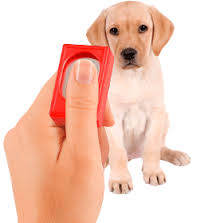There are several different ways to get a behavior from your dog. In this article I am going to look at two that are very common, and talk about when I use them, and why.
Many dog trainers (perhaps even the majority), regardless of methodology, begin training by using the lure and reward method. This method involves the handler holding a treat directly in front of the dog’s nose in order to move the dog int o the desired position. This method can be used to quickly achieve a position, at which time the dog earns the treat that is in front of him.
o the desired position. This method can be used to quickly achieve a position, at which time the dog earns the treat that is in front of him.
Pros: Luring can provide fast results. By placing a treat directly in front of your dog’s nose and lifting it up above his head you can cause his bottom to go downward as he attempts to maintain contact with the treat. It provides a quick result, and can encourage the handler to continue practicing until mastery is gained.
Cons: Repeated luring can lead the dog to too strongly associate the lure with the behavior, leaving you with a dog that only works when the treat is dangled right in front of him. While a skilled trainer can fade the lure quickly, some average dog owners have difficulty. Luring also does not ask the dog to actually think about what he is doing. He is thinking “treat”, his bottom hits the floor, he gets the treat. He is not being required to use his mind and make the connection, and only does so through many repetitions. Imagine you are going to dinner with a friend in a place you have never driven before. You want to take separate cars, so you follow your friend. You get to the destination just fine, but you may not know exactly how you got there because you weren’t thinking about where you were. You were just focused on the back end of your friend’s car.
 Another method, which can be used in conjunction with or instead of luring, is capturing. In capturing, the trainer waits until the dog performs a behavior on his own and captures it with a marker, like a clicker. It’s like taking a snap shot of a behavior you like so your dog will know exactly what he did right. The marker has already been associated with something the dog likes, so the dog learns that the marker means he is doing what he is supposed to. When you mark a behavior a few times, the dog begins performing it in order to earn the click.
Another method, which can be used in conjunction with or instead of luring, is capturing. In capturing, the trainer waits until the dog performs a behavior on his own and captures it with a marker, like a clicker. It’s like taking a snap shot of a behavior you like so your dog will know exactly what he did right. The marker has already been associated with something the dog likes, so the dog learns that the marker means he is doing what he is supposed to. When you mark a behavior a few times, the dog begins performing it in order to earn the click.
Pros: The dog is thinking, and the overall time needed to learn a specific behavior is typically less than with luring. In addition, the dog can perform the behavior anywhere in the room in relation to the trainer, so the dog does not get stuck with the idea that sit absolutely MUST be right in front of his owner. It is also easier to extend out the amount of time the dog stays in position by simply extending the time before the click. Finally, there is no lure or body language of any kind involved on the trainer’s part, so there will be no lure to fade, and no risk of you having to touch the floor every time you want your dog to lie down.
Cons: The initial behavior may take longer to get, and trainers who are unfamiliar with the ultimate success of the method may grow impatient, leading them to resort to other methods to train the dog.
Both luring and capturing are useful methods in getting the behaviors you want from your dog. Once their limitations are understood, you can easily work around them. For instance, I only lure the dog three times with the treat and three times with an empty hand before I start capturing a behavior. This does away with the risk that the dog will only perform when you have a treat on his nose. I also reserve luring specifically for behaviors that the dog does not perform naturally. Anything the dog is going to do anyway I simply capture. With patience, capturing the behavior has huge payoffs in setting the behavior into the dog’s long term memory.
